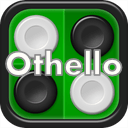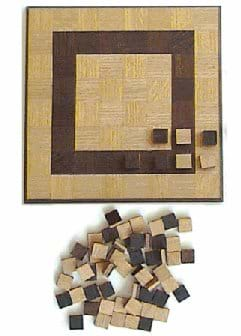Game History - Othello Game


The photograph on the right is a Reversi board in the Museum collection. According
to Whitehill, Reversi is a British antecedent for the game of Othello. Parlett
(Oxford History of Board Games, p. 178) writes that Reversi was patented in 1888 in
England, but Reversi seemed to be based upon an earlier game issued in England in
1870 known as Annexation. The earlier game was played on a standard checkerboard,
while Reversi was played on a board similar to the one pictured on the left.
Whitehill indicates that McLaughlin Brothers marketed the game of Reversi in the U.S.
in 1888 as well.
The wooden board in the photograph however, was purchased by the Museum from a shop
in Copenhagen, Denmark in 1975 where it was manufactured. The board is19.9cm square on
top, and is laminated to 20.8cm square board on the bottom. The sides of the board on
top slope to the bottom making the board 1.2cm thick. The top has a parquet like
surface of 2.5cm squares. The 64 counters are 1.5cm square with light colored wood on
one side, laminated to a square of a dark colored wood. Thus the counters can be
"reversed" during play of the game. Counters are stored in a suede bag.
Chinese Friends
Both Whitehill and Parlett indicate that Reversi was popular in Europe, North
America and elsewhere until about 1920. Later, it was re-issued by a number of
publishers under a variety of names and designs and again gained some recognition
until 1968.

The photograph above on the right is one of the latter editions of Reversi under
the name "Chinese Friends". This copy was donated to the Museum in 1971, although it
had been manufactured and sold for a number of years before that by a U.S. company -
World Wide Games, Delaware, Ohio. The board is 29.5cm square and .5cm thick. The 58
counters are made of cardboard, printed with red on one side and black on the "reverse".
In 1968, Goro Hasegawa published a new version of Reversi which he named Othello.
This new version modified some of the play of the game, and its popularity started to
spread to Europe and North America. It was first published in the United States in 1976
as a board game, and continued to be published by different manufacturers over the next
few decades.
Hoyle Board

The photograph on the left is of an electronic version of the game donated to the
Museum in 1982. It was a "cartridge" game that attached to a home television set through
an Atari console game machine. The board appeared on the television screen, and two
players interacted and played the game with a type of "game controller" attached to the
game machine.
Eventually, this type of technology for play of the game gave way to specialized
software on a home computer for the game of Othello. And the circle came around again,
when in 1998, Sierra published a CDRom of Board Games that included their version of
Reversi for use on a "pc".
Game Tips - Othello Game
While it might seem like flipping as many discs as possible is the key to victory,
this actually makes you more vulnerable. Most positions on the board can be outflanked.
The edges of the board and the corners are the most stable positions. Discs in the
corners cannot be outflanked and discs along the edges are harder to outflank, so work
towards getting discs in the edges and corners of the board.
Avoid playing discs in the spaces immediately next to the extreme corners or next to
the edge rows whenever possible, as this gives your opponent the chance to outflank you
and gain the corner position.
Flipping lots of discs early on actually gives your opponent an advantage. Instead,
make moves that only flip over 1 or 2 discs until you have played about half or more of
your discs. By waiting to make big moves, your opponent will be more limited in what
they can do.